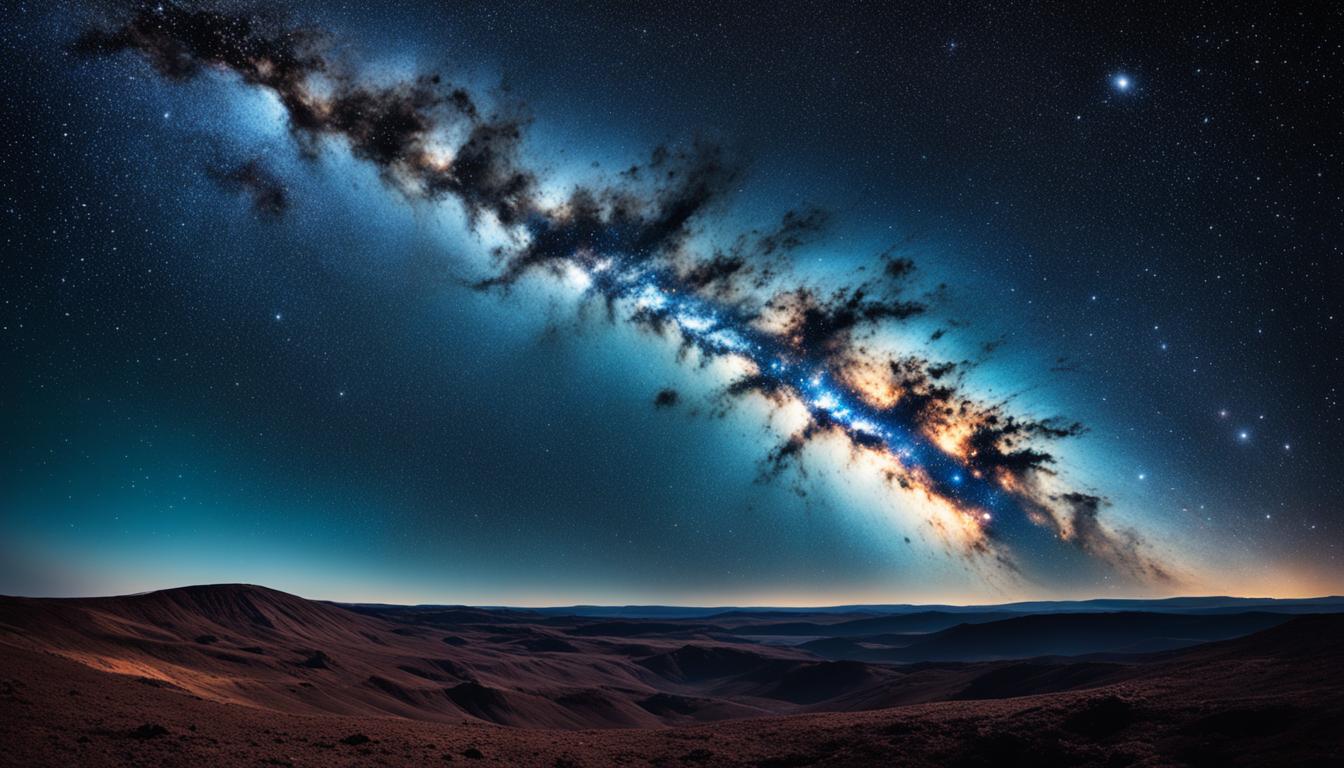Exploring the universe’s boundaries could stay a dream because of hard-to-understand theoretical limitations, technological constraints, and the massive vastness of cosmic scales. This article looks into why we might not make it to the edge of the observable universe. It covers reasons like the extreme distances of space and the rules of physics. Let’s talk about why it’s so hard to achieve cosmic exploration.
Key Takeaways
- The vastness of the cosmos poses immense challenges for interstellar exploration due to the astronomical distances between celestial bodies.
- Fundamental laws of physics, such as the speed of light barrier and energy limitations, limit our ability to reach the edge of the observable universe.
- Significant astrophysical unknowns and uncertainties, including dark matter and dark energy, further complicate the prospect of reaching the cosmic boundaries.
- The finite age of the universe, increasing entropy, and the eventual heat death of the cosmos present additional obstacles to cosmic exploration.
- Profound philosophical and existential questions about the nature of infinity and our place in the universe are raised by the challenge of reaching the edge of the observable universe.
The Vastness of the Cosmos
The cosmic scale and astronomical distances make exploring space a huge task. These distances are too massive. Even at the speed of light, it would take millions or billions of years to travel across them.
Unfathomable Distances
After the Big Bang, the universe grew to immense sizes. Galaxies and other objects are far apart. It’s impossible to reach them in a human or species’ lifetime.
Cosmic Expansion and the Big Bang
The Big Bang theory says everything started small and then grew. This growth makes distances big between parts of the universe. Even the hope of going to the universe’s edge faces challenges because space keeps expanding.
Limitations of Modern Astrophysics
The cosmos has astrophysical constraints that are hard to imagine. But besides these, the laws of physics and our current tech also stop us. They create big challenges for going to the edge of the observable universe. The speed of light barrier and the huge energy limitations in quantum physics-based travel are key issues.
The Speed of Light Barrier
The speed of light is a constant speed that nothing can beat. This limit makes interstellar travel really hard. Even though we think about warp drives or wormholes, physics says things with mass can’t go faster than light. This stops us from traveling the massive spaces between stars and galaxies too quickly.
Fuel and Energy Constraints
Getting past the speed of light barrier needs an incredible amount of energy. Existing propulsion systems don’t have the power to push us so far. We might need breakthroughs in areas like nuclear fusion or advanced quantum energy to move forward. These new technologies could be what’s needed for real space exploration.
Astrophysical Unknowns and Uncertainties
Despite making huge steps in astrophysical studies, our universe still has many secrets. The biggest mysteries are dark matter and dark energy. They fill most of space but are hard to understand. This makes it tough to fully grasp the cosmic horizons and the unknown physics that rule the universe.
Scientists are working hard to understand the hidden forces that change the astrophysical world. This includes how galaxies start and how the universe grows. But, understanding these is tricky because the universe keeps getting bigger. This goes against what we believe now.
It’s key to solve the dark matter and dark energy puzzles. They are vital in learning about the universe’s shape and how it moves. Even though these secrets are among the top astrophysical mysteries, solving them would open many doors for us.
Learning more means accepting that there’s a lot we don’t know. This journey makes us ask new questions and challenge old ideas. It shows how much we can still learn about the universe and its hidden physics.
The Finite Age of the Universe
Studying the cosmos, we find a clear truth: the universe is not forever. The Big Bang theory first showed us this. It makes it hard to imagine ever seeing the universe’s end.
Cosmic Timelines and Entropy
About 13.8 billion years ago, everything started with the Big Bang. Since then, the universe keeps getting bigger and changing. The entropy of it all just keeps growing.
Heat Death and the End of Time
As the universe expands, everything inside it moves towards heat death. This is when every bit of energy is used up. At that point, the universe will be just a cold, empty place. The idea of finding the end of the universe is a big challenge with this future ahead of us.

Philosophical and Existential Quandaries
Trying to reach the edge of the universe brings up big philosophical implications. We start to wonder about the nature of the universe and where we fit in. The vastness of space makes us question what we really understand.
The Nature of Infinity
The universe’s vastness and the thought it might be infinite show our limits. Philosophical speculations about the nature of infinity shake up what we think we know. It challenges our human understanding in new ways.
The Quest for Knowledge and Understanding
Wanting to get to the universe’s edge is all about learning and understanding more. This journey is a deep need to grasp the nature of the universe and where we stand. It shows our natural urge to explore and solve the cosmic mysteries.
Technological Limitations and Challenges
Breaking the boundaries of cosmic exploration faces real hurdles. These include technological and resource obstacles. To get to the edge of the universe, we need better ways to move through space. This must be sustainable through long missions, despite scarce resources and environmental pressures.
Propulsion Systems and Interstellar Travel
Our current spacecraft and rockets can’t quite make it to other stars. The energy and fuel they need are too much. Even our best technology can’t do it. We look to things like nuclear fusion for a solution, but these are challenging.
Resource Scarcity and Sustainability
Going far into space for a long time needs a lot of resources. Things like fuel and life support are a must. Yet, using up resources and staying sustainable for centuries pose big challenges. To tackle this, we should aim for recycling, using local resources, and better life support.

Conclusion
Exploring the edge of the observable universe is very hard. There are many astrophysical, theoretical, and technological challenges. They might be too hard to overcome. The cosmos is incredibly vast, and the laws of physics complicated.
The future of cosmic exploration is exciting but full of limits. The universe’s huge size and our limited science hold us back. Yet, the quest for understanding goes on, even if the final goal seems impossible.
Still, striving to know the unknown is vital. Human cosmic exploration, through new discoveries and tech, increases our universe knowledge. Even if we can’t reach the universe’s edge, the journey teaches us a lot.
